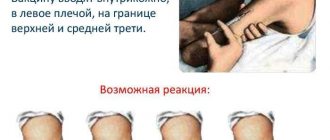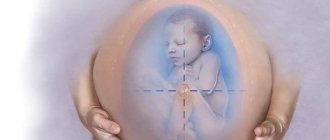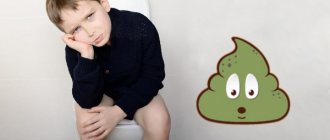January 22, 2019
Averyanova Sveta
The list of “bad” habits in babies is quite long. This includes finger sucking, nose picking, hair pulling and many others. Some children develop the habit of constantly picking at their belly button.
Stereotypical behavior can go away on its own with age or become ingrained as a patterned ritual to calm down. Most parents try to rid their babies of this habit right away. We'll tell you in our article how to wean it and what to do if a child picks at the navel due to emotional discomfort.
Bad habits
If adults have bad habits, then so do children. Therefore, it is important to closely monitor your child in order to notice in time a harmful change in the behavior of the child, especially the youngest. As children age, they try to explore their bodies, this starts at 5 months. The baby examines his hands, bringing them to his face, lifts his legs up, and touches them.
In addition to studying his body, the child tries to taste everything: his fingers, the blanket, and toys. This behavior is considered absolutely normal, because the baby is just learning about the world. And he himself doesn’t even understand how the next little thing ended up in his mouth, because the child pulls them at the level of instincts.
Babies quickly learn about all the objects around them, try to touch and twist something, and in addition to this, they imitate adult expressions of facial actions, for example, smiling or sticking out their tongues, and also squeal and squeal at the voice of mom and dad.
Such actions of the child serve as a kind of stage in the development of his motor and mental abilities. When the baby performs absolutely normal actions, you only need to make sure that he doesn’t get hurt or put something dirty in his mouth. But there are actions that, having committed once, a child unconsciously repeats them again and can harm himself in this way, because it becomes a habit. There are a lot of them. But this article will talk about why a child picks his navel, what are the reasons for this and what this action can lead to. We will also tell you what parents should do.
Scientists have explained why you should not press your finger on your navel
If you experience a strange feeling of discomfort when touching your belly button, then know that you are not alone, this is a normal reaction. American doctor Christopher Hollingsworth from NYC Surgical Associates explained that if you insert a finger into the navel and press, the person will experience a strong desire to relieve himself. This is because pressing the navel is like pressing a button that triggers a physiological reaction within the body.
When you insert a finger into the belly button and apply pressure, Dr. Hollingsworth says, it sends a signal from the deep fibers in the abdomen to the spinal cord...
The spinal cord interprets this impulse as a signal that the bladder is full, and so the person has a desire to visit the toilet as soon as possible. But when he gets there, he can’t relieve himself because the signal was false.
IN THE TOPIC: 7 unexpected places on the body where you should apply perfume
However, for such a reaction, you need to press on the navel hard enough to activate the nerve fibers located behind the muscle layer of the abdomen. However, the navel itself is also very sensitive, so if you stroke it lightly - without deep pressure - it can be very pleasant. Many people call the navel their erogenous zone.
Well, if you want to play a little with your belly button or the belly button of your sexual partner, you can always do it, just use soft touches and strokes - otherwise you will overdo it and will have to quickly run small...
ON THE TOPIC: Doctors explained why it is dangerous to take a smartphone to the toilet
A child picks his belly button. Reasons of a physiological nature
Overly worried mothers, suspecting something is wrong in their child’s behavior, may immediately take him to a child psychologist, which will only scare the child. This is, of course, a way out of the current situation. But before taking extreme measures, you should try to find out the reason yourself. And many manage to do this.
In fact, the reason why a child constantly picks his belly button should be obvious. In order to find out, just watch the baby. There are only two explanations for such non-standard behavior of children, which lie in physiological and psychological factors.
The first are associated with any anxiety in the baby's navel area - he experiences discomfort in this area of the abdomen. That's why he touches her often. If the cause is physiological, then it may manifest itself externally, so parents should carefully examine this area of the body. There may be redness or a rash that itches around the belly button. There are also scratches in this part, causing pain and discomfort to the baby.
Therefore, if a child picks his belly button, the first step is to carefully examine the abdomen for rashes, abrasions and cuts, as well as any other abnormal changes.
Another warning sign should be the baby’s unusual behavior – refusal to eat, elevated body temperature, tearfulness and lethargy. The combination of these symptoms with belly button picking may indicate the presence of a disease.
As soon as the listed signs appear or spots, redness, or even worse discharge appear on the tummy, you should immediately take the child to the doctor.
Diseases localized in the umbilical region
Pathological processes in which a child picks at the navel may be accompanied by the appearance of an inflammation process or pass without it. The most common pathologies are:
- Hernial protrusion of the umbilical cord. This is a developmental defect that may result in a liver or intestinal segment being inserted into the umbilical cord loop. To eliminate this pathology, surgical therapy is used.
- Amniotic navel. The occurrence of this defect is accompanied by the absence of the epidermal layer on the umbilical surface. Basically does not require special therapy.
- Omphalitis. An inflammatory process of bacterial etiology, which involves tissues and vessels around the navel.
- Development of phlegmon. An acute inflammatory process that develops in the tissues of subcutaneous fat. The skin turns red, the baby vomits, and the body temperature increases sharply. The disease is dangerous, since the infection through the bloodstream can spread throughout the body, causing new foci of inflammation.
- Umbilical sepsis. It is a consequence of insufficient or complete absence of treatment for omphalitis. This pathology can cause death.
- The necrotic process in the umbilical region is characterized by tissue damage with a deepening inward, which creates the risk of an inflammatory process in the retroperitoneal space (peritonitis). This condition is associated with the need for urgent surgical intervention.
Hernia
Hernia is considered one of the common diseases in young children. It can be formed due to non-standard natural data - a large umbilical ring or weak abdominal muscles. It is not difficult to notice; the hernia seems to protrude above the skin. But sometimes she tends to be drawn inward. The child does not understand that this is an abnormal condition of his navel, and tries to play with the hernia, pressing on it so that it hides under the skin and looks back out. This process does not bring pain to the baby, so he finds it interesting, but parents must understand that this requires mandatory medical intervention so that complications with the child’s health do not arise in the future.
If any pimple or bump is found on the child’s abdomen, it should be shown to a surgeon. He will quickly identify what it is and prescribe treatment or surgery. The main thing is to seek help in time. If a child picks at the navel for physiological reasons, then with the removal of the same hernia the habit will soon be forgotten.
Consequences of navel picking
Inflammation of the navel
Picking your belly button can have unpleasant consequences:
- scratching the skin in the folds of the navel;
- ingress of dirt, infection;
- the development of an inflammatory and sometimes purulent process due to the difficulty of access to the depth of the scar folds;
- formation of omphalitis, furunculosis;
- the need for surgery to remove or cleanse the inflammation.
The same thing happens in adults if a person unsuccessfully cleaned or scratched the area of the umbilical fossa.
It is important to regularly examine even a navel that has healed after birth and teach the child to observe the rules of personal hygiene from a young age.
Emotions
But it happens that not everything is so easy to identify! And touching the navel became a bad habit. You need to find out the psychological factor behind this action.
Navel picking may be associated with the manifestation of certain emotions:
- Anxiety.
- Anger.
- Aggressive behavior.
- Nervous overexcitation.
- Resentment.
- Sadness.
- And plain boredom.
All of these emotions are more negative than positive. And the root cause of their manifestation may be hidden not only in the mental state of the baby, but also in the home environment in which he is constantly located. If parents often quarrel among themselves or lash out at the child, then his reaction with touching the navel may be defensive behavior or fear. In addition to parents, negatively-minded relatives - brothers, sisters, grandmothers, as well as any persons in contact with him who can frighten the child - can cause unusual behavior in the child.
Types of omphalitis, signs of the clinical picture
In the pathogenesis of this pathological process, the main role is played by the penetration of staphylococci or Escherichia coli into the umbilical cord. The disease may have a catarrhal or purulent form. In addition to the uncomfortable sensations that are accompanied by frequent touching of the baby to the umbilical area, the following symptoms develop:
- serous discharge appears;
- the navel area becomes bright red;
- the temperature indicator, increasing, can reach 38 degrees;
- Crusts form on the resulting wound surface, and when you try to separate them, a weeping surface is formed.
The lack of proper therapy causes the development of purulent omphalitis, which is characterized by the release of purulent contents when pressing on the umbilical area. A long course is a provoking factor in the development of tissue necrosis with the subsequent occurrence of sepsis.
Family relationships
From infancy, children feel a negative atmosphere in the family, where outwardly everything is stable and good - there is an apartment, a car, they go on vacation, but psychologically there are only quarrels and scandals. The baby is not yet able to speak, so he cannot open his feelings about conflicts to adults, therefore, he has to do it differently. For this reason, the child picks the navel.
If everything is normal in the family and there is no negativity, then other children or their parents, with whom the child is forced to spend time on the playground or in kindergarten, can have a bad influence on the baby. The child is still too young to stand up to others. Therefore, he splashes out his feelings on the navel. Perhaps this helps him to distract himself and calm down.
Pupology: 5 naive questions about the navel
There is a well-established expression “the navel will be untied.” Could this really be the case? I did some digging on the Internet. Here's what I found. Removes all questions. It would seem that there could be something so interesting in this navel. Meanwhile, few people know, for example... Where does the navel lead? The navel leads nowhere. Previously, when he was still very small, an infant navel, he went through difficult days: at first he was part of the umbilical cord and helped the owner to eat and breathe, and then he was cut off, tied tightly, and smeared with lapis. After that, his tail withered and fell off and he became an ordinary, familiar, neat and no longer leading anywhere obligatory attribute of any person. The main thing is that it is not tied with a bow. This leads to an equally interesting question... Can a belly button come undone? The navel can only come undone if it is not tied correctly, that is, in the first days after birth. In this case, it begins to bleed and the child may die. But this happens extremely rarely. Any obstetrician ties belly buttons correctly. This is only in some emergency conditions, when someone random has to give birth, without experience in such manipulations, somewhere in military field conditions. In an adult, the navel cannot come undone - it is fused. That is, if a person begins to notice that a liquid with an unpleasant odor is constantly secreted in his navel, this does not mean at all that the navel has “come loose” and some intestinal contents are “leaking.” The navel has nothing to do with the intestines. And the moisture indicates that he is injured. This should be avoided, because the navel heals very poorly and takes a long time. There are no blood vessels, but many lymphatic vessels, and it is easy to get infected there. Hence the next question... How to properly care for your belly button? The main thing in this matter is caution: do not reach into the navel with your fingers, so as not to accidentally scratch it with your nail. After bathing, be sure to gently dry your belly button. Use a cotton swab. If, nevertheless, a wound is inflicted, do not cover the injured navel with cotton wool or seal it with a band-aid. Just treat it with brilliant green and do not block the air access to the navel. Many people have a deep navel, while obese people have a flattened, flattened navel; they must not forget that the navel must “breathe.” Try not to squeeze the skin at the waist with tight belts and waistbands. Also, don't overdo it with your piercings. Hence the next question... What is the maximum permissible concentration of earrings in the navel? Their number, of course, can be limited only by the aesthetic taste of the owner of the navel and its size. There are two pitfalls here: firstly, never do piercing using artisanal methods - only specialists and sterility! An introduced infection can lead to dire consequences: suppuration, and even necrosis - tissue death. Do not forget about this, otherwise in place of the navel, decorated with an earring, only an unsightly scar will remain. Secondly, the navel with earrings must be protected from mechanical damage. Indulging in lovemaking, playing sports, and even just changing clothes, you can accidentally open the way to the navel for infection. But you can tear your navel not only by pulling the earring. Hence the next question... What does it mean to “tear the navel”? This is the same as “earning” an umbilical hernia. This trouble occurs for two reasons: a long cry (this mainly applies to newborns) and sudden lifting of weights. Both cause severe tension in the abdominal wall. The anterior abdominal wall consists of many layers. The muscles near the navel end, forming the so-called “umbilical” ring. Its lumen is covered with a very thick layer of connective tissue. Due to sudden or prolonged strong tension, it stratifies and the nearby part of the intestine protrudes into the “weak spot”. A bag is formed, fraught with pinching and other troubles. In principle, no one is safe from hernia. To avoid these troubles, do not lift excessive loads and do not let children scream. Be healthy, take care of your navels. Read in the next issue of Pupology: What the navel can tell about a man’s temperament.
- home
- Health
- Why can't you touch your belly button?
Very often we believe in superstitions, believing that this is a scientifically proven prohibition. There are more than enough such examples, for example, many still believe that it is impossible to look at the moon and admire its beauty.
One of the interesting representatives of such beliefs of the twenty-first century is the eternal question of why you should not touch the navel. Of course, this fact remains open, because no logical explanations are given, perhaps it’s just fiction?
Self-injury
Why does a child pick his belly button? One of the worst reasons for this is self-aggression. It happens. The child does this action specifically to cause pain. In addition to touching the navel, the baby deliberately pinches and scratches himself, sometimes until blood appears.
When parents notice such behavior in a child, they should take him to a psychologist. You cannot do without a doctor in this situation, because this is a sign of the onset of a serious psychological illness, and if measures are not taken in time, it can go into an irreversible stage.
Picking the navel itself can lead to injury and the development of infection or disease.
Parents must understand that the child does this for a reason, but with the goal of removing negativity and calming down. And if you shout at the baby, he will get even more scared, and the situation will only get worse.
Is it possible to touch the navel
Massage of the umbilical area improves digestion
You can touch your navel. There is even a special massage of the peri-umbilical area, which has a beneficial effect on the peritoneal organs. It is forbidden to pick at it or touch it with dirty hands. This can cause inflammation.
The navel of a baby is a sensitive area; touching it causes discomfort. Touching a newborn's navel requires great care. After the baby is born, a small wound is located at the site of the fallen umbilical cord. The wound surface must be carefully treated to avoid inflammation.
What not to do?
If a child picks his belly button, what should you do? What actions should you not take? You can’t shout at the child, try to seal the navel, smear it, or even worse, hit the baby’s hands. It won't help.
Ridiculing a child’s bad habit or comparing him with other children can influence the formation of an inferiority complex in him, which will significantly spoil his future life.
Asking your child to promise not to do this again is also not the best option. Because children are rarely responsible for their words.
Punishment is also not the best measure to combat a bad habit. Most likely, the child will pick his belly button to annoy his parents. You need to approach the problem intelligently.
What to avoid
It is important to understand whether these actions are an attempt at emotional release for the child. Because in this case it is in no way possible:
- In strict form and under pain of punishment, forbid the baby to do this, since this will only aggravate the situation.
- You should not obstruct access to the navel by covering it with an adhesive plaster, hitting your hands or raising your voice at the baby.
- You cannot make fun of a child’s unhealthy habit and compare him with someone else. Otherwise, this will lead to the formation of an inferiority complex and self-doubt.
- There is no need to make your child promise that he will no longer engage in such activities. Children cannot keep promises, and systematic violation of them will lead to the same actions in adulthood.
- Any punishment is prohibited. Parents often make mistakes by telling their child: “if you pull the belly button, you will be left without a cartoon,” “if you disobey your parents, you will stay at home and not go anywhere,” and similar threats. This can lead to a backlash, and then the baby will do it to spite you. Moreover, additional bad habits (such as nail biting) may develop.
Recommendations
How to stop a child from picking his belly button?
In order to cope with your baby’s emerging habit, you need to:
- Find the reason for this behavior.
- Spend more time with your child.
- Ask your children how they spend their day and what exciting things happened.
- If a bad habit manifests itself when parents yell at a child, then you need to find another way to calm it down.
- Come up with as many activities as possible so that the children don't get bored. It is best to take them to a puppet theater, rides, etc.
- Find friends for your child or help him meet peers. Lack of communication also has a detrimental effect on the psyche.
- There is no need to punish a child for such a habit, but it is better to observe him and find a calm solution.
- Children should not be prohibited from showing emotions in the form of tears or screaming. Of course, as long as they don't cross the line. This is a way of expressing emotions, getting rid of negativity, and calming down.
- The surest option to stop a child from picking his belly button is to find him an interesting activity - drawing, playing with friends, enrolling him in a class.
- If your child loves to draw, then you can develop these abilities. This hobby helps to depict all negative emotions on paper.
- Children very often have bad dreams that reveal their hidden fears. You can ask the child to talk about what he saw, then you can understand what is bothering him. And before going to bed, it’s better to tell him good fairy tales or stories.
- If picking the navel is a kind of ritual, then you need to replace it with a more useful one.
- Children who are too spoiled cannot control their emotions and behavior, and then bad habits arise. To solve this problem, it is worth creating a daily routine that needs to be followed, this helps to discipline the baby.
Is it possible to untie the navel? If so, what will happen? If not, why not?
Stasya Spirina 391 4 years ago Student of Org State Medical University. Editor of the Fleming Medical Project
The navel is a scar on the anterior abdominal wall that remains after the umbilical cord falls off in newborns. The concept of “untied navel” does not exist. This refers to the phenomenon of umbilical hernia.
External abdominal hernia is the protrusion of the internal organs of the abdominal cavity, covered with the parietal peritoneum, through natural or pathological openings in the muscular aponeurotic layer (the so-called weak points), the anterior, posterior abdominal wall and pelvic floor into the subcutaneous fat while maintaining the integrity of the skin.
The cause of hernias is a discrepancy between the density and strength of the abdominal wall (pelvic floor) and intra-abdominal pressure. And the factors that lead to the development of a hernia are divided into contributing and producing. Contributing factors include (i.e. factors that help reduce the force of resistance to intra-abdominal pressure): increased body weight, impaired innervation and trophism of muscles, enlarged opening of weak points, features of the anatomical structure of the area where the hernia emerges, weakness of the muscular and ligamentous apparatus of the anterior abdominal wall, injuries , operations, heredity, etc.
Directly producing factors (i.e. factors leading to increased intra-abdominal pressure): prolonged constipation, difficulty urinating, chronic lung diseases manifested by prolonged cough, heavy physical labor, emergency lifting).
In this case, the “weak point” of the anterior abdominal wall is the umbilical ring, because in this area, the anterior abdominal wall consists of skin, connective tissue, transverse fascia, and peritoneum. There are no dense aponeurotic and muscle fibers that effectively resist intra-abdominal pressure, therefore, with a combination of promoting and producing factors, hernias often occur in the navel area.
Umbilical hernias can occur at different ages. There are embryonic, childhood and adult hernias.
Fetal hernias occur during the period when the anterior abdominal wall has not yet fully formed.
The contents of embryonic hernias can be the small intestine, liver, colon, Meckel's diverticulum, stomach.
In the first months of a child’s life (usually up to 6 months), umbilical hernias of childhood may occur. They are formed in cases where the umbilical ring has not completely formed.
The opinion that umbilical hernia in children occurs due to the inexperience or carelessness of midwives, who may “incorrectly” cut the umbilical cord after childbirth is not true, because modern technology of applying a special umbilical staple cannot affect the occurrence of a hernia. And improper care of the umbilical cord and umbilical wound and, as a result, inflammation (omphalitis) can result, when combined with producing factors.
Often, an umbilical hernia in adults occurs in women due to pregnancy (twice as often as in men). This is facilitated by a number of factors: 1) in pregnant women, the uterus increases in size by 40 times and puts pressure on the internal organs, which leads to an increase in intra-abdominal pressure.
2) stretching of the umbilical ring associated with an increase in abdominal circumference;
3) decreased tone of the abdominal muscles and umbilical ring.
The hernial contents of umbilical hernias are most often the omentum, small and large intestines.
Therefore, when symptoms of an umbilical hernia are detected, pregnant women are recommended to wear bondage and engage in physical therapy to prevent hernia complications (such as strangulation of the hernial sac, coprostasis, irreducibility, organ damage, inflammation of the hernial sac). The only radical treatment for an umbilical hernia is surgery, which can be performed even on an outpatient basis, when she becomes a young mother and finishes breastfeeding.
So the line from the famous song: a knot is tied, a knot is untied - not about the navel










